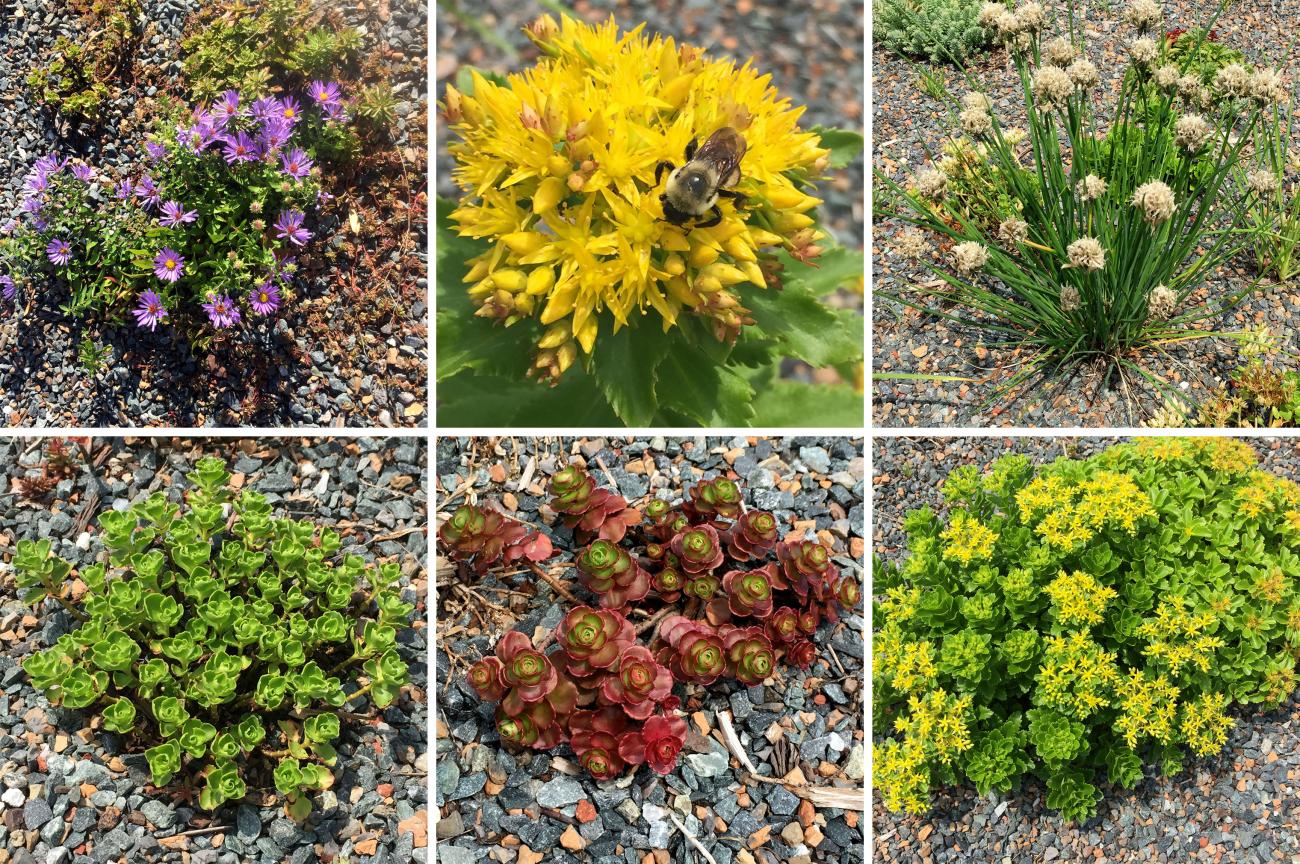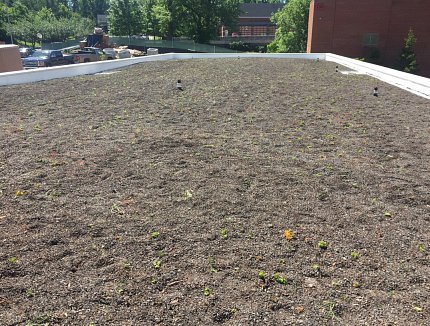One Year Later
Latest Campus Green Roof Shows Progress, Promise

Photo: Brandon Hartz
“It’s not easy being green.” With apologies to Kermit the Frog, the latest eco-friendly roof installment on campus, at the Northwest Child Care Center, hasn’t found any difficulties yet being green. In fact, it’s quickly becoming a model for future structures.
“Green roofs are only going to become more prevalent on campus,” predicts NIH landscape architect Brandon Hartz. “Any major construction project has a good chance of having a green roof. This is due to stormwater permit requirements from the Maryland department of the environment. Green roofs are one of a number of stormwater mitigation solutions in an engineer’s toolbox.”
More than a year after green roof contractors installed 3 plant plugs per square foot—54,000 plugs total—on top of the NWCCC at the corner of Center Drive and Convent Drive, the plants are thriving with about 50 percent coverage. About 17 different sedums and 9 other flowering perennials—26 different plant species—are growing in the space.
According to a 24-month contract, a professional green roof company visits every 6-8 weeks to measure progress of the plants and coverage, weed the area and watch for any signs of trouble. Evidence of tree saplings, for instance, poses a danger as “strong roots could damage the integrity of the roof’s water-proofing system,” Hartz said. Birds and other wildlife could inadvertently plant tree seed via their droppings. So far, so good on that front, however.
From the bottom up, the roof consists of a layer of waterproofing over the top of the building, a protection board, a root barrier, a drainage board, 1-inch water retention element or mineral wool and 4 inches of green roof granular media visible to passersby. As blooming occurs, that material becomes obscured by vegetation.

Photo: Brandon Hartz
“What makes these green roofs really beautiful is the diversity of plant material that can grow up there,” Hartz said. Already blooming are October Skies (aromatic aster), chives, ice plant, geranium and several colorful varieties of sedum, including creeping stonecrop in red, green and yellow.
“The great thing about sedum plants, too, is that if branches of it fall off or get knocked off the main plant for whatever reason, those branches will just reroot and a new plant will grow in that area,” Hartz explained.
In 2007, NIH installed its first green roof (and one of Montgomery County’s first) at the Gateway Center. At the NWCCC roof, future greenery was planted in a scattershot fashion, so if one thing didn’t bloom as expected, its thriving neighbor could provide coverage in the area. That way, fewer chances for bare spots overall.

Photo: Brandon Hartz
In 2009, the NIH Library opened its 4,400-square-foot green roof terrace, which has a 1,200-gallon cistern undergirding it. It’s by far the largest on campus. Several other more modest stormwater management solutions also reside on NIH grounds, near the Lister Hill Auditorium for instance and beneath a few campus parking lots.
Aside from the beauty year round of the green roofs, the practical purposes for the environmentally kind installations have become more obvious as well.
“They’re more resilient than grass to drought conditions and they do not have to be mowed every week,” Hartz concluded. “We’d always have to deal with drainage of stormwater in one way or another, but with green roofs you have the advantage of an aesthetic view. Also, with green roofs, the roots of the plants will actually help filter out pollutants from the water…It makes the natural processes visible. It’s not just a functional landscape, but it’s also a beautiful landscape. It does double duty in that way.”
NIH’s Eco-Friendly Toppers
Below are the campus’s green roofs that have shallow soil profiles.
- Gateway Center Bldg.
- Visitor Parking Garage
- NIH Library Terrace
- Northwest Child Care Center
- Bldg. 35A
- Electrical substation (between Bldgs. 37 and 40)
